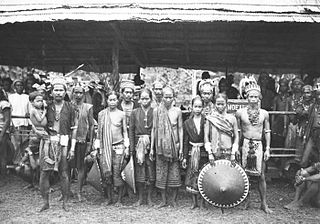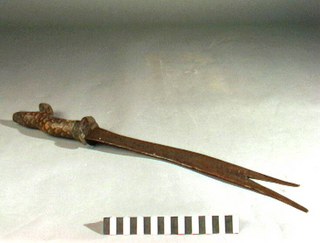The Batin are a sub-group of Malay people that inhabits the interior parts of Jambi province

The kujang is a bladed weapon native to the Sundanese people of West Java, Indonesia. The earliest kujang made is from around the 8th or 9th century. It is forged out of iron, steel, and pattern welding steel with a length of approximately 20–25 cm and weighs about 300 grams. According to Sanghyang siksakanda ng karesian canto XVII, the kujang was the weapon of farmers and has its roots in agricultural use. It is thought to have originated from its predecessor, a kudi. The kujang is one of the traditional weapons in the Sundanese school of pencak silat. The kujang, like the keris, is a blade of sentimental and spiritual value to the people of Indonesia, who have a vast belief in supernatural powers.
Limboto is a town in Indonesia and the administrative centre of Gorontalo Regency.

Gorontalo people, also known as Gorontalese are a native ethnic group and the most populous ethnicity in the northern part of Sulawesi. The Gorontalo people have traditionally been concentrated in the provinces of Gorontalo, North Sulawesi, and the northern part of Central Sulawesi.

Mualang are an indigenous people of West Kalimantan from the Dayak group and a sub-ethnic of the Iban people. They speak the Mualang language and they are mostly concentrated in areas in the Sekadau Regency and Sintang Regency of West Kalimantan, Indonesia. The specific districts where the Mualang people live include:
- Belitang Hilir district, Sekadau
- Belitang district, Sekadau
- Belitang Hulu district, Sekadau
- Sepauk, Sintang and its surrounding region

The Pandat is the war sword of the Dayak people of northwest Borneo and is never used as a tool. On October 18, 2016, this weapon was featured in season 3 episode 9 of the American bladesmithing competition series Forged in Fire.
Mangkeng is a ceremony used by the Betawi people, who traditionally live in the coastal villages of Jakarta. The ceremony is used at important public gatherings and especially at weddings. The main purpose is to bring good luck and ward off the rain. It is performed by the village shaman, also called the Pangkeng shaman, where the name originates.

The Kanta is a traditional shield of the Toraja and Pamona people of Tana Toraja Regency, South Sulawesi and Poso Regency, Central Sulawesi, Indonesia respectively.

The Lampung or Lampungese are an indigenous ethnic group native to Lampung and some parts of South Sumatra, Bengkulu, as well as in the southwest coast of Banten. They speak the Lampung language, a Lampungic language estimated to have 1.5 million speakers.

Soerabaia 45 is an Indonesian film released in 1990. The film was directed by Imam Tantowi and starred Nyoman Swadayani, Leo Kristi, and Usman Effendy. The story of the film is based on the 1945 Battle of Surabaya between pro-independence Indonesian soldiers and militia against British and British Indian troops as a part of the Indonesian National Revolution.

Islam in Central Sulawesi, a province of Indonesia, is the majority religion embraced by around 75% of the province's 2,683,722 inhabitants . The propagators of Islam were thought to enter Central Sulawesi through neighboring regions, namely Bone, Wajo, and Mandar from the south and west routes, and through Gorontalo and Ternate from the north and east routes via Tomini Bay and Tolo Bay.
A Pujungan Inscription, also called Bronze Tongtong Inscription, is a short inscription written on a copper slit drum, which was found in the village of Pujungan in Pupuan District, Tabanan Regency, Bali, Indonesia. This inscription is thought to have been written during the reign of King Anak Wungsu in the 11th century. This is the first inscription that mentions the name Sasak, the name of the indigenous people of Lombok island.
Mona Lohanda was an Indonesian historian, archivist and academic, as well as a curator of the National Archives of Indonesia. She was a leading authority on the history of Batavia, as well as its Chinese-Indonesian community.

A kudi or kudhi is a bladed tool from Banyumas, Indonesia.

Dra. Augustine Magdalena Waworuntu, was an Indonesian politician who became the first post-federal Indonesian mayor of Manado and the first female mayor of Manado.

The Moso is a sword found throughout the Alor Archipelago up to Sulawesi, Indonesia.

Penai is a machete-like sword found in Sulawesi, Indonesia. Traditionally, it is used for both war and agricultural tools. It is used by the Bare'e speaking Torajan people and Pamona people.

Rugi is a traditional sword originating from Wetar and Alor Island, Indonesia. It is also referred to as Rugi Glamang.

The Bara Sangihe sword originates from North Sulawesi, Indonesia.

The Tangkin is a traditional parang (knife) of the Iban people from Sarawak, Malaysia and West Kalimantan, Indonesia.


















